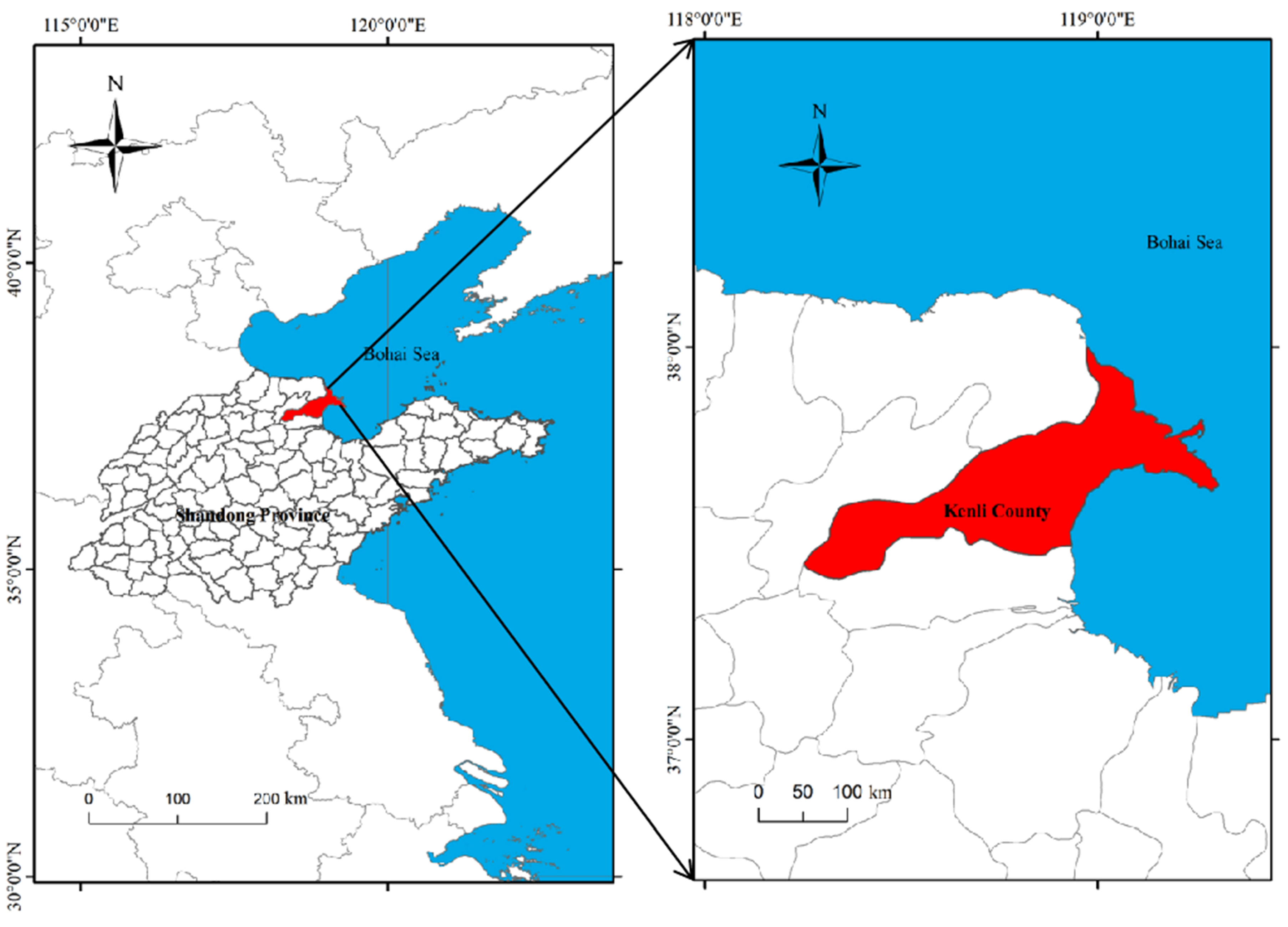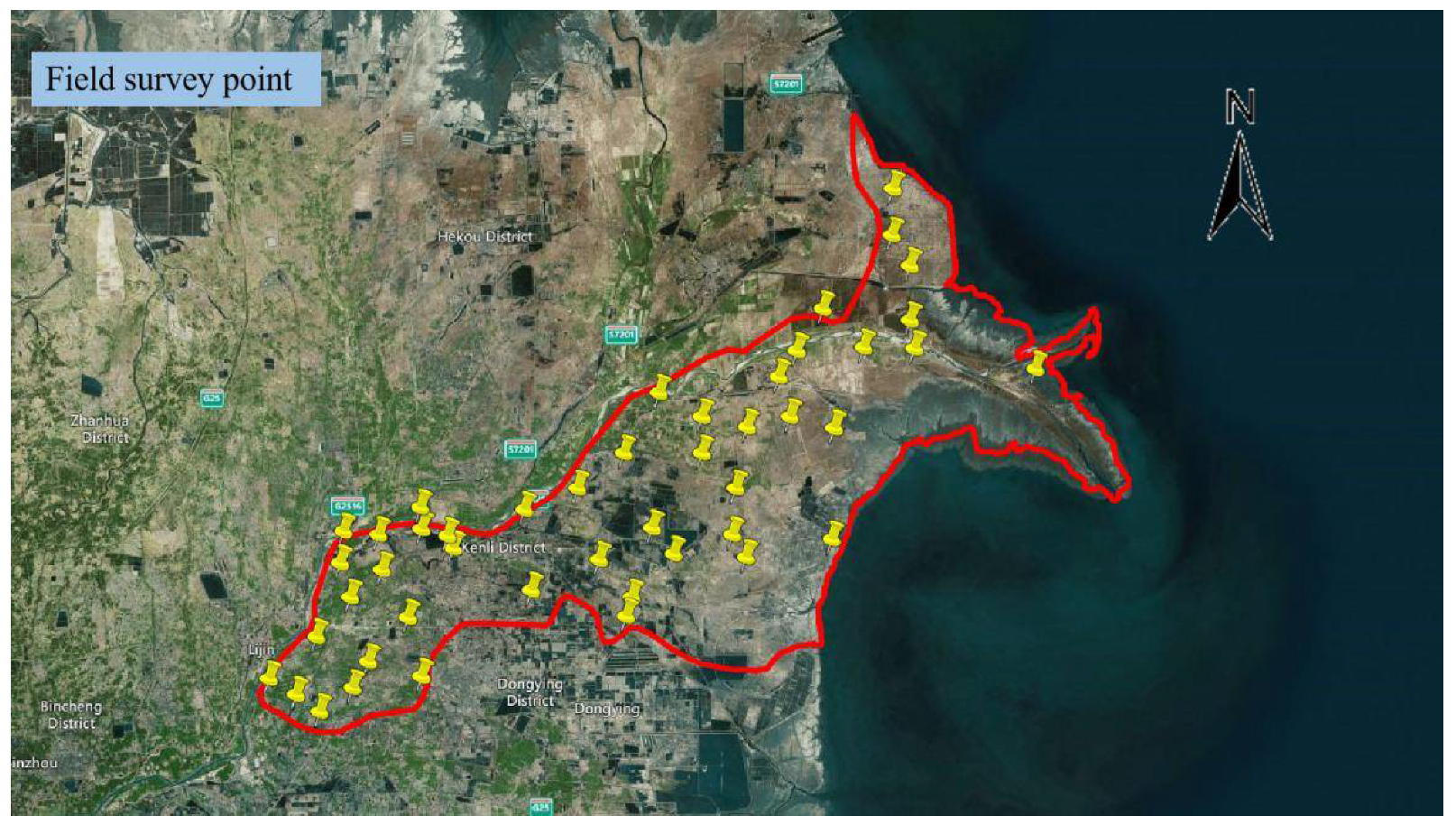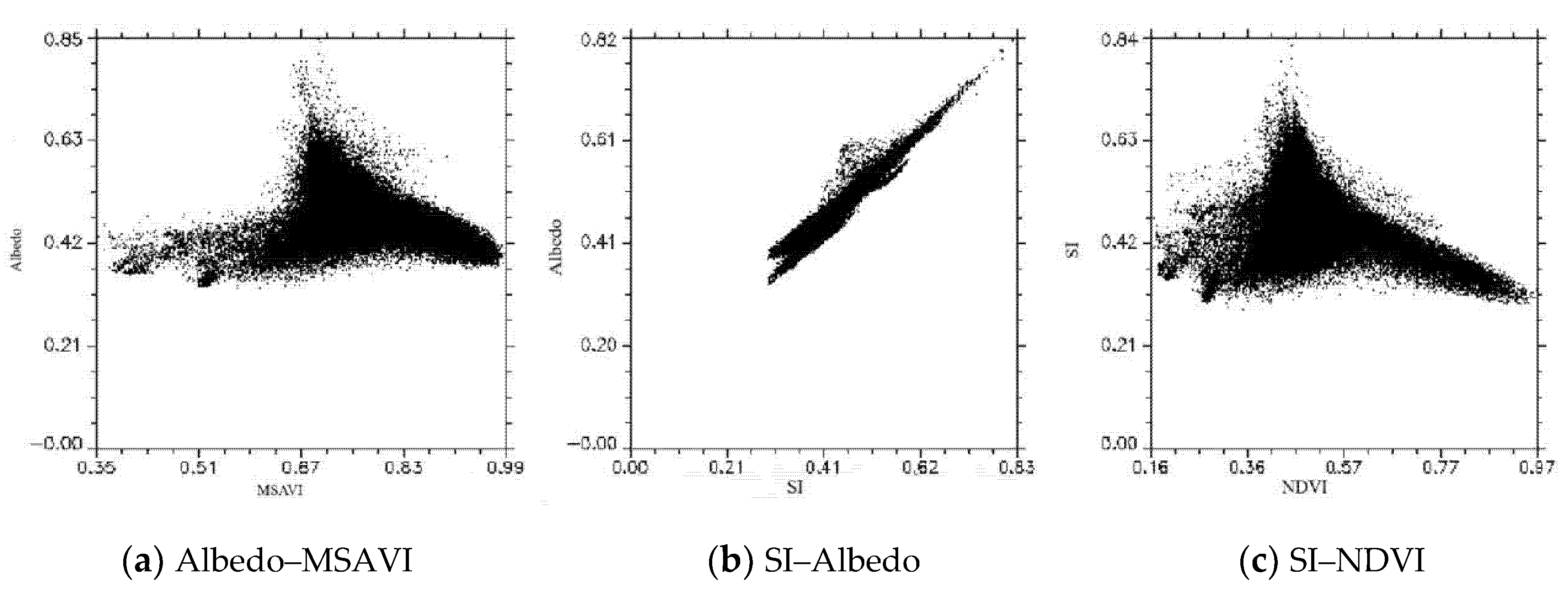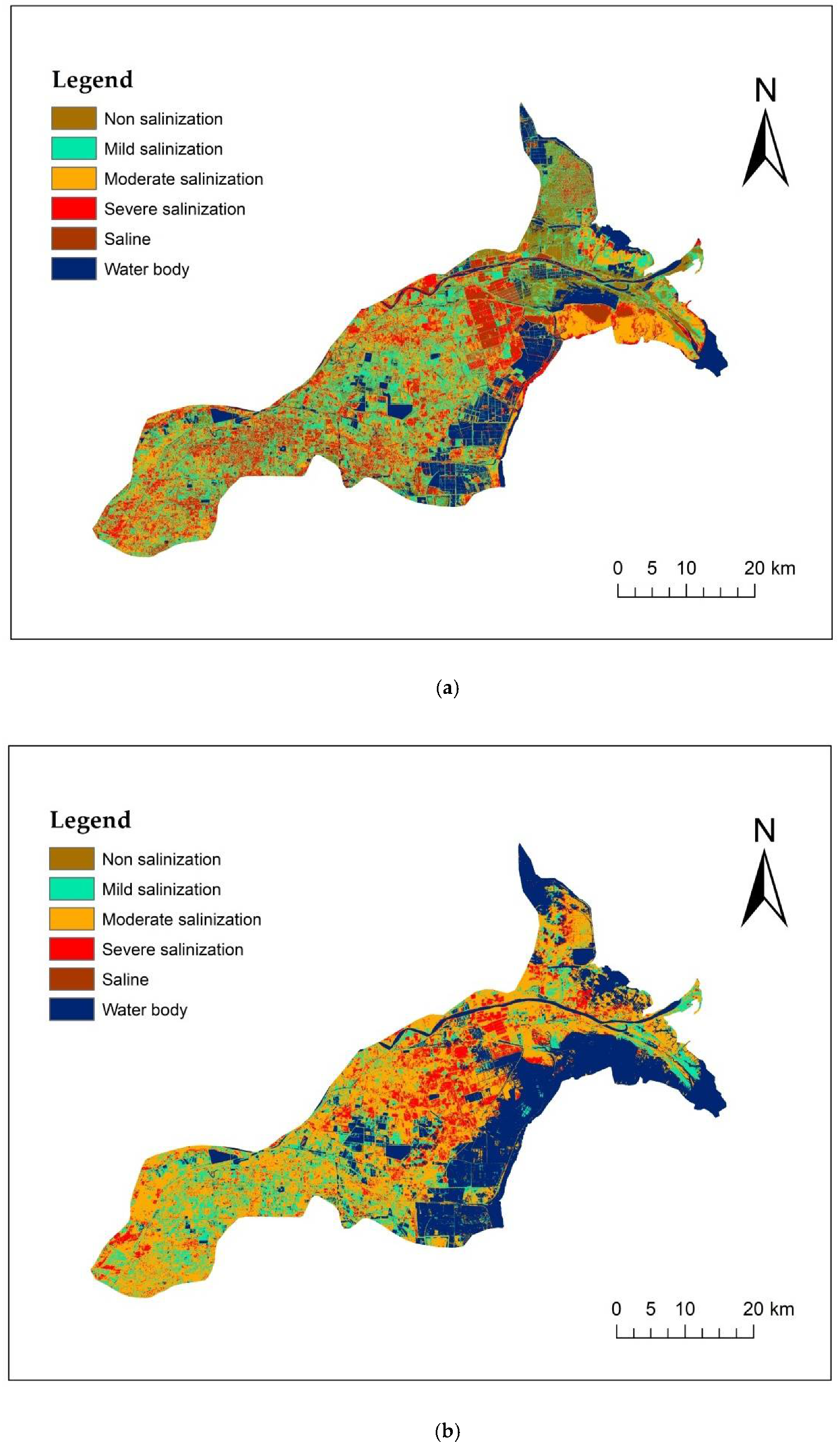Spatiotemporal Changes of Soil Salinization in the Yellow River Delta of China from 2015 to 2019
Abstract
1. Introduction
2. Materials and Methods
2.1. Overview of the Study Area
2.2. Data Sources
2.3. Methods
2.3.1. Feature Parameters
Albedo
Modified Soil-Adjusted Vegetation Index (MSAVI)
Normalized Difference Vegetation Index (NDVI)
Salinity Index (SI)
2.3.2. Feature Space Principle
Surface Albedo–MSAVI Feature Space
Salinity Index–Surface Albedo (SI–Albedo) Feature Space
SI–NDVI Feature Space
Space Inversion Model
3. Results
3.1. Inversion Results and Classification
3.2. Spatial and Temporal Distributions and Changes
4. Discussion
5. Conclusions
Author Contributions
Funding
Institutional Review Board Statement
Informed Consent Statement
Data Availability Statement
Acknowledgments
Conflicts of Interest
References
- Perri, S.; Suweis, S.; Holmes, A.; Marpu, P.R.; Entekhabi, D.; Molini, A. River basin salinization as a form of aridity. Proc. Natl. Acad. Sci. USA 2020, 117, 17635–17642. [Google Scholar] [CrossRef]
- Guo, H.D. A Project on big Earth data science engineering. Bull. Chin. Acad. Sci. 2018, 33, 818–824. [Google Scholar] [CrossRef]
- Wang, X.M.; Zhou, X.H. Estimation and inversion modeling of salinity of cotton field soil using remote sensing in the delta oasis of Weigan and Kuqa rivers. Agric. Res. Arid. Areas 2018, 36, 250–254. [Google Scholar] [CrossRef]
- Gong, Y.L. Inversion of bare surface soil salinity based on microwave remote sensing. Jiangsu Agric. Sci. 2015, 43, 442–444. [Google Scholar]
- Feng, J.; Ding, J.L.; Wei, W.Y. Soil salinization monitoring based on Radar data. Remote Sens. Land Resour. 2019, 31, 195–203. [Google Scholar] [CrossRef]
- Wu, C.S.; Huang, C.; Liu, G.H.; Liu, Q.S. Spatial prediction of soil salinity in the yellow river delta based on geographically weighted regression. Resour. Sci. 2016, 38, 704–713. [Google Scholar] [CrossRef][Green Version]
- Allbed, A.; Kumar, L. Soil salinity mapping and monitoring in arid and semi-arid regions using remote sensing technology: A review. Adv. Remote Sens. 2013, 2, 13. [Google Scholar] [CrossRef]
- Ghassemi, A.; Jakeman, A.J.; Nix, H.A. Salinisation of Land and Water Resources: Human Causes, Extent, Management and Case Studies; NSW University Press: Sydney, Australia, 1995; ISBN 0868401986. [Google Scholar]
- Mashimbye, Z.E.; Cho, M.A.; Nell, J.P.; De Clercq, W.P.; Van Niekerk, A.; Turner, D.P. Model-based integrated methods for quantitative estimation of soil salinity from hyperspectral remote sensing data: A case study of selected South African soils. Pedosphere 2012, 22, 640–649. [Google Scholar] [CrossRef]
- Gou, Q.Q.; Han, Z.W.; Wang, G.H. Research progress on soil salinization in arid irrigated area of Northwestern China. Chin. Agric. Sci. Bull. 2011, 27, 246–250. [Google Scholar]
- Zuo, T.; He, L.; Zhang, J.M. Dynamic change in coastal soil salinization based on the CA-Markov model. Resour. Sci. 2014, 36, 1298–1305. [Google Scholar]
- Zhang, X.G.; Lai, H.Y.; Li, X.L.; Li, S.M.; Cui, D.J. Spatial and temporal variation of soil salinity in Kenli county of the yellow river delta area in recent ten years. Yellow River 2019, 41, 64–68. [Google Scholar]
- Farifteh, J.; Van der Meer, F.; Atzberger, C.; Carranza, E.J.M. Quantitative analysis of salt-affected soil reflectance spectra: A comparison of two adaptive methods (PLSR and ANN). Remote Sens. Environ. 2007, 110, 59–78. [Google Scholar] [CrossRef]
- Yang, L.; Huang, C.; Liu, G.H.; Zhu, A.X. Mapping soil salinity using a similarity-based prediction approach: A case study in Huanghe river delta, China. China Geogr. Sci. 2015, 25, 283–294. [Google Scholar] [CrossRef]
- Azabdaftari, A.; Sunar, F. Soil salinity mapping using multitemporal landsat data. The international archives of the photogrammetry. Int. Arch. Photogramm. Remote Sens. Spat. Inf. Sci. 2016, 41, B7. [Google Scholar] [CrossRef]
- Morgan, R.S.; El-Hady, M.A.; Rahim, I.S. Soil salinity mapping utilizing sentinel-2 and neural networks. Indian J. Agric. Res. 2018, 52, 524–529. [Google Scholar] [CrossRef]
- Hoa, P.V.; Giang, N.V.; Binh, N.A.; Hai, L.V.H.; Pham, T.D.; Hasanlou, M.; Bui, D.T. Soil salinity mapping using SAR sentinel-1 data and advanced machine learning algorithms: A case study at ben tre province of the Mekong river delta (Vietnam). Remote Sens. 2019, 11, 128. [Google Scholar] [CrossRef]
- Ding, J.L.; Qu, J.; Sun, Y.M.; Zhang, Y.F. The retrieval model of soil salinization information in arid region based on MSAVI-WI feature space: A case study of the delta oasis in Weigan-Kuqa watershed. Geogr. Res. 2013, 32, 223–232. [Google Scholar]
- Yang, X.; Wu, J.J.; Yan, F.; Zhang, J. Assessment of regional soil moisture status based on characteristics of surface temperature/vegetation index space. Acta Ecol. Sin. 2009, 29, 1205–1216. [Google Scholar] [CrossRef]
- Feng, J.; Jing, J.L.; Wei, W.Y. A Study of soil salinization in Weigan and Kuqa rivers oasis based on Albedo-MSAVI feature space. China Rural Water Hydropower 2018, 2, 147–152. [Google Scholar] [CrossRef]
- Wang, F.; Ding, J.L.; Wu, M.C. Remote sensing monitoring models of soil salinization based on NDVI-SI feature space. Trans. China Soc. Agric. Eng. 2010, 26, 168–173. [Google Scholar] [CrossRef]
- Ha, X.P.; Ding, J.L.; Tiyip, T.; Luo, J.Y.; Zhang, F. SI-Albedo space-based extraction of salinization information in Arid area. Acta Pedol. Sin. 2009, 46, 381–390. [Google Scholar] [CrossRef]
- Ma, C. Quantitative retrieval of soil salt content in the Songnen plain based on HJ1A-HSI images. Arid. Zone Res. 2014, 31, 226–230. [Google Scholar] [CrossRef]
- Ma, C. Quantitative retrieval of soil salt content based on Sentinel-1 dual polarization radar image. Trans. China Soc. Agric. Eng. 2018, 34, 153–158. [Google Scholar] [CrossRef]
- Guo, B.; Yang, F.; Fan, Y.W.; Han, B.M.; Chen, S.T.; Yang, W.N. Dynamic monitoring of soil salinization in yellow river delta utilizing MSAVI–SI feature space models with Landsat images. Environ. Earth Sci. 2019, 78, 1–10. [Google Scholar]
- Li, Y.H.; Ding, J.L.; Sun, Y.M.; Wang, G.; Wang, L. Remote sensing monitoring models of soil salinization based on the three dimensional feature space of MSAVI-WI-SI. Res. Soil Water Conserv. 2015, 22, 113–117. [Google Scholar] [CrossRef]
- Xiao, D.P.; Tao, F.L.; Moiwo, J.P. Research progress on surface Albedo under global change. Adv. Earth Sci. 2011, 26, 1217–1224. [Google Scholar] [CrossRef]
- Liang, S.L. Narrowband to broadband conversions of land surface albedo: Algorithms. Remote Sens. Environ. 2001, 76, 213–238. [Google Scholar] [CrossRef]
- Qi, J.; Chehbouni, A.; Huete, A.R.; Kerr, Y.H.; Sorooshian, S. A modified soil adjusted vegetation index. Remote Sens. Environ. 1994, 48, 119–126. [Google Scholar] [CrossRef]
- Daliakopoulos, I.N.; Tsanis, I.K.; Koutroulis, A.; Kourgialasa, N.N.; Varouchakisa, A.E.; Karatzasa, G.P.; Ritsemac, C.J. The threat of soil salinity: A European scale review. Sci. Total Environ. 2016, 573, 727–739. [Google Scholar] [CrossRef]
- Carlson, T.N.; Ripley, D.A. On the relation between NDVI, fractional vegetation cover, and leaf area index. Remote Sens. Environ. 1997, 62, 241–252. [Google Scholar] [CrossRef]
- Khan, N.M.; Sato, Y. Monitoring hydro-salinity status and its impact in irrigated semi-arid areas using IRS-1B LISS-II data. Asian J. Geoinform. 2001, 1, 63–73. [Google Scholar]
- Sandholt, I.; Rasmussen, K.; Andersen, J. A simple interpretation of the surface temperature/vegetation index space for assessment of surface moisture status. Remote Sens. Environ. 2002, 79, 213–224. [Google Scholar] [CrossRef]
- Wu, Z.P.; Wang, M.X.; Zhao, X. A study on desertification based on desertification difference index in Jinghe watershed. Bull. Soil Water Conserv. 2014, 34, 188–192. [Google Scholar] [CrossRef]
- Lu, R.K. Analytical Methods of Soil Agricultural Chemistry; China Agricultural Science Press: Beijing, China, 2000; ISBN 7-80119-925-1. [Google Scholar]
- Hu, Y.Y.; Wang, R.Y.; Chen, H.Y.; Li, Y.P.; Liu, Y.Q. Research on remote sensing retrieval and temporal variation of soil salinity in the spring and autumn of the yellow river delta. Geomat. Spat. Inform. Technol. 2018, 41, 78–81. [Google Scholar] [CrossRef]
- Wang, Z.R.; Zhao, G.X.; Gao, M.X.; Jiang, S.Q.; Chang, C.Y.; Jia, J.C. Characteristics of soil water and salt spatial variations in the spring season in typical yellow river delta areas of Kenli county. China J. Agric. Resour. Environ. 2015, 32, 154–161. [Google Scholar] [CrossRef]
- Zhang, G.L.; Wu, H.Y. From “problems” to “solutions”: Soil functions for realization of sustainable development goals. Bull. Chin. Acad. Sci. 2018, 33, 124–134. [Google Scholar] [CrossRef]
- Wu, C.H.; Zhao, S.P.; Liu, Q.Q.; Ren, J.Y.; Zhang, Q.G. Engineering forestation model of the yellow river delta region—Taking dongying forestry ecological construction project as an example. J. Anhui Agric. Sci. 2018, 46, 84–87. [Google Scholar] [CrossRef]
- Liu, P.; Wang, X.; Wen, F.; Liu, Y.; Sun, Z.; Zhang, C.; Yan, M.; Fan, L. Development and application of big data platform for “Bohai granary”. Wirel. Pers. Commun. 2018, 103, 275–293. [Google Scholar] [CrossRef]
- Ma, X.; Wu, J.; Xie, Y.; Song, M. Implementation of science and technology demonstration project in Dongying, Shandong province. World Trop. Agric. Inform. 2020, 1, 10–11. [Google Scholar]
- Leng, C.; Zheng, F.; Zhao, B.; Liu, H.; Wang, Y. Advances on alkaline tolerance of rice. Biotechnol. Bull. 2020, 36, 103–111. [Google Scholar]






| Degree of Salinity | Nonsalinization | Mild Salinization | Moderate Salinization | Severe Salinization | Saline Soil |
|---|---|---|---|---|---|
| Albedo–MSAVI | ≤0.85 | >0.85, ≤0.88 | >0.88, ≤0.89 | >0.89, ≤0.90 | >0.90, ≤0.98 |
| SI–Albedo | ≤0.17 | >0.17, ≤0.23 | >0.23, ≤0.29 | >0.29, ≤0.35 | >0.35, ≤0.60 |
| SI–NDVI | ≤0.56 | >0.56, ≤0.61 | >0.61, ≤0.66 | >0.66, ≤0.69 | >0.69, ≤0.90 |
| Model | Correct Classification | Wrong Classification | Overall Accuracy | |
|---|---|---|---|---|
| 2015 | Albedo–MSAVI | 31 | 7 | 81.6% |
| SI–Albedo | 33 | 5 | 86.8% | |
| SI–NDVI | 28 | 10 | 73.7% | |
| 2019 | Albedo–MSAVI | 39 | 8 | 82.9% |
| SI–Albedo | 41 | 6 | 87.2% | |
| SI–NDVI | 38 | 9 | 80.9% |
Publisher’s Note: MDPI stays neutral with regard to jurisdictional claims in published maps and institutional affiliations. |
© 2021 by the authors. Licensee MDPI, Basel, Switzerland. This article is an open access article distributed under the terms and conditions of the Creative Commons Attribution (CC BY) license (http://creativecommons.org/licenses/by/4.0/).
Share and Cite
Bian, L.; Wang, J.; Liu, J.; Han, B. Spatiotemporal Changes of Soil Salinization in the Yellow River Delta of China from 2015 to 2019. Sustainability 2021, 13, 822. https://doi.org/10.3390/su13020822
Bian L, Wang J, Liu J, Han B. Spatiotemporal Changes of Soil Salinization in the Yellow River Delta of China from 2015 to 2019. Sustainability. 2021; 13(2):822. https://doi.org/10.3390/su13020822
Chicago/Turabian StyleBian, Lingling, Juanle Wang, Jing Liu, and Baomin Han. 2021. "Spatiotemporal Changes of Soil Salinization in the Yellow River Delta of China from 2015 to 2019" Sustainability 13, no. 2: 822. https://doi.org/10.3390/su13020822
APA StyleBian, L., Wang, J., Liu, J., & Han, B. (2021). Spatiotemporal Changes of Soil Salinization in the Yellow River Delta of China from 2015 to 2019. Sustainability, 13(2), 822. https://doi.org/10.3390/su13020822





